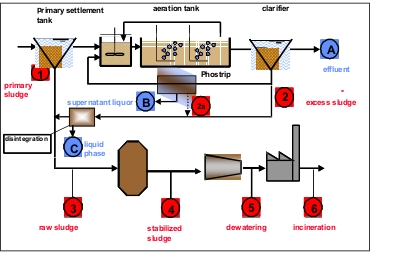Phosphorus recovery from wastewater, sewage sludge and sewage sludge ashes (ProPhos)
The objective of this joint research project of Technische Universität Darmstadt in cooperation with Leibniz Universität Hannover and Universität Karlsruhe is to investigate and to optimise the options of phosphorus recovery (P-recovery) in waste water treatment plants (WWTPs see figure 1). WWTPs are a significant source for phosphorus recovery. The aim is to create a technically and commercially feasible low contaminated product that can substitute raw phosphate used in the phosphate industry or can be used as fertilizer directly. The joint research project is divided into three studies: Study A1 (Leibniz Universität Hannover/ ISAH) and Study A2 (Universität Karlruhe/ Soil moisture group) focus on P-recovery from the liquid phase (main stream, side streams or sludge liquor). Study B (Technische Universität Darmstadt/ Institute WAR) looks into P-recovery from sewage sludge ashes and sludge. Institute WAR also coordinates the joint research activities.

Figure 1: Different possibilities for phosphorus recovery
ProPhos Study A1: Recovery of phosphorus from the liquid phase, increase of the phosphorus concentration in the liquid phase and MAP precipitation
ISAH Leibniz Universität Hannover
Considering phosphorus recovery from the liquid phase, there are three main waste water streams where P-recovery as MAP (Struvite, Magnesiumammoniumphosphate) or as Calciumphosphate is feasible: 1. Precipitation in the final effluent (A); 2. in a side stream from return activated sludge (B) or thickened surplus sludge (C) - both combined with phosphorus release from (EBPR) (enhanced biological phosphorus removal) sludges or 3. from sludge liquor (5).
The main goals are therefore:
a) Optimising the release of phosphorus from the sludge recycle stream and excess sludge into the liquid phase. The boundary conditions for the maximisation of phosphorus release determined in laboratory scale experiments and later verified with data from full scale WWTPs.
b) Assessment of input and efficiency of different disintegration technologies in view of P-recovery. This will be done by measurements and evaluation of existing data and considering two different disintegration methods/ processes (homogeniser, ultra sonic).
c) Determination of the optimal working point for MAP precipitation as an alternative to the phosphorus crystallisation induced through calcium silicate hydrates (CSHs) that is tested in Study A2.
d) Evaluation and modelling of the maximum P-recovery potential from the liquid phase depending on the employed technology and the used waste water stream based on the data of Projects A1 and A2.
ProPhos Study A2: P-Recovery from the liquid phase by cristallisation as calcium phosphate on a pilot scale.
Universität Karlsruhe, soil moisture group
Study A2 focuses on the removal and P-recovery from wastewater through calcium silicate hydrates (CSHs) - induced crystallisation of calcium phosphate that can be recycled in the fertilizer or phosphate industries. Pilot scale cristallisation reactors (moving bed, stirred reactor) are being tested on WWTP in the final effluent (A) and sides streams.
The study focuses on process optimisation and characterisation of adequate seeding material. In cooperation with the Universität Hannover the feasibility of phosphorus recovery from supernatant liquor will be tested and compared to MAP precipitation on a laboratory scale.
ProPhos Study B: Phosphorus recovery from sewage sludge and sewage sludge ashes
Technische Universität Darmstadt, Institute WAR
Study B focuses on the recovery of phosphorus from sewage-sludge ashes and from the sludge itself. Phosphorus removal in municipal waste water treatment is based on transferring and concentrating phosphorus from the liquid phase into the sludge either by biological incorporation into the biomass or by use of precipitants allowing for a potential recovery of 90% of phosphorus from sludge or sludge ashes. However, chemical or chemical-thermal treatment steps are required to dissolve the fixated phosphorus and to separate it out. This leads to higher chemical and energy costs and consequently an unfavourable environmental performance.
The way phosphorus is chemically bound in the sludge and sludge ashes has an influence on the efficiency of chemical phosphorus extraction methods and depends on the applied phosphorus removal technology (biological and/or chemical).
The research project therefore investigates the influence of different sludge characteristics (aluminium, iron, calcium and magnesium content) and applied sludge treatment technologies (anaerobic mesophil/thermophil and aerobic mesophil/thermophil) on the way phosphorus is fixated.
In this context it will be investigated if and how it is possible to influence the phosphorus fixation process during sewage sludge treatment by the addition of phosphorus fixating materials that can be separated from the phosphorus depleted sludge.
Furthermore recovery of chemically extracted phosphorus from sewage sludge ashes and sewage by precipitation, membrane filtration and ion exchange will be investigated.








